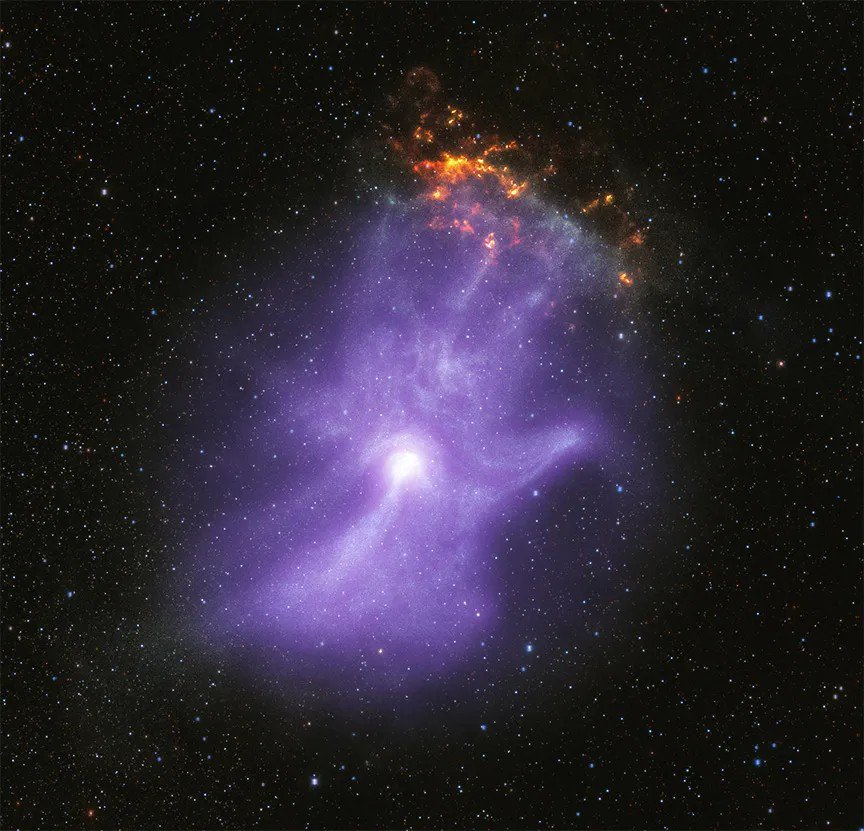NASA Finds Ghostly Cosmic Hand 16,000 Light-Years From Earth
In a discovery which seems to have leapt straight out of the pages of a science fiction novel, NASA X-rays have revealed a so-called cosmic “ghost hand” in the reaches of space. This research, which has been reported by a write-up in NASA.gov, has identified the bones of this ghost hand as the magnetic structure of a collapsed star over 16,000 light years from the atmosphere of Earth. The ghost hand serves as one of many examples tying the structure of human anatomy to that of complex systems in biology across the universe.
NASA has found what looks like a massive ghost hand, but is actually the magnetic structure of a collapsed star.

Though the discovery was just recently reported by NASA, the research which resulted in the ghost hand’s imaging dates back to the late 1800s, when German mechanical engineer and physicist Wilhelm Röntgen discovered X-ray imaging. The famed Nobel laureate experimented with the technology by taking images of his wife’s hand bones, kicking off the revolutionary diagnostic capabilities of X-ray technology. Now, over a century later, NASA telescopes have become fitted with X-rays in order to utilize their imaging powers in the magnetic reaches of outer space.
A series of charged particles have been traveling along the pulsar’s magnetic field, resulting in a shape remarkably similar to a human hand’s bone structure.
As a result of these NASA X-rays, astronomers were able to locate a complex magnetic field within the distant wind nebula MSH 15-52. The magnetic field, which scientists have called the ghost hand or the pulsar PSR B1509-58, is remarkable in its construction, as it looks nearly identical when mapped to that of a human hand under an X-ray.
Though the hand stretches far and wide over a complex web of magnetic poles, the pulsar seems to be the result of a giant star not unlike our yellow sun, which ran out of nuclear fuel and collapsed onto itself over 1,500 years ago.
NASA’s Chandra X-ray Observatory has remained locked on the discovery for over 17 days, marking the longest consecutive study of any single object using the technology. Though the Observatory only began utilizing X-ray capabilities in December of 2021, this ghost hand seems to be a massive discovery, with profound implications regarding the nature of space-bound anatomy.
Halloween fanatics are likely holding out hope that the ghost hand comes as part of a complete ghost skeleton set.
According to Stanford University researcher Roger Romani, who led the study of the ghost hand, a series of charged particles have been traveling along the pulsar’s magnetic field, resulting in a shape remarkably similar to a human hand’s bone structure.
NASA also confirmed that their study of the ghost hand has resulted in a number of interesting findings, including unusually straight and uniform magnetic fields within the pulsar, indicating an absence of turbulence in the wind nebula. This discovery supports the leading theory that the star collapsed over 1,500 years ago, leading scientists to wonder just what other magnetic signatures have been left behind by similar implosions across the universe.
As NASA continues to monitor the situation, Halloween fanatics are likely holding out hope that the ghost hand comes as part of a complete ghost skeleton set. After all, the only spooky Autumnal decoration capable of outshining the famed Home Depot 12-foot skeleton would be a massive and ancient space-bound corpse, bones writhing with cosmic magnetism. With any luck, the relatively new X-ray technology NASA is utilizing may hold more results soon.











